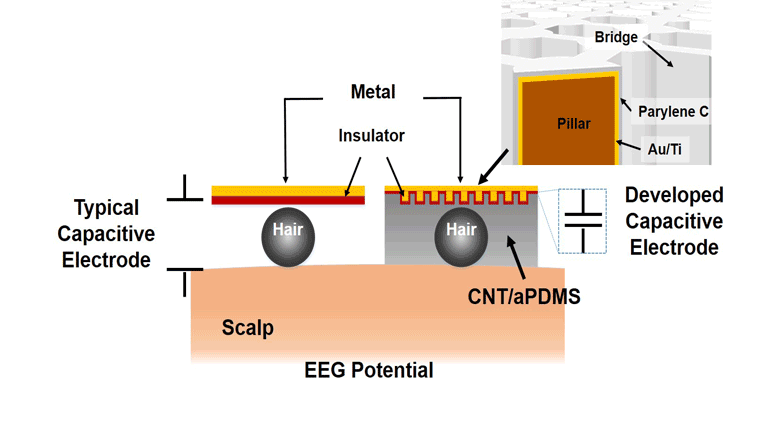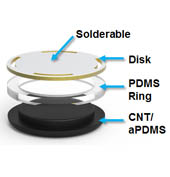 Seung Min Lee, Jeong Hun Kim, Cheolsoo Park, Ji-Young Hwang, Joung Sook Hong, Kwang Ho Lee, Sang Hoon Lee, Gwangwoon University, Soongsil University, Kangwon National University, Korea University, Korea
Seung Min Lee, Jeong Hun Kim, Cheolsoo Park, Ji-Young Hwang, Joung Sook Hong, Kwang Ho Lee, Sang Hoon Lee, Gwangwoon University, Soongsil University, Kangwon National University, Korea University, Korea
We fabricated a carbon nanotube (CNT)/adhesive polydimethylsiloxane (aPDMS) composite-based dry electroencephalograph (EEG) electrode for capacitive measuring of EEG signals. As research related to brain–computer interface applications has advanced, the presence of hairs on a patient’s scalp has continued to present an obstacle to recorder EEG signals using dry electrodes. The CNT/aPDMS electrode developed here is elastic, highly conductive, self-adhesive, and capable of making conformal contact with and attaching to a hairy scalp. Onto the conductive disk, hundreds of conductive pillars coated with Parylene C insulation layer were fabricated. A CNT/aPDMS layer was attached on the disk to transmit biosignals to the pillar. The top of disk was designed to be solderable, which enables the electrode to be connected with a variety of commercial EEG acquisition systems. The mechanical and electrical characteristics of the electrode were tested, and the performances of the electrodes were evaluated by recording EEGs, including alpha rhythms, auditory-evoked potentials, and steady-state visually-evoked potentials. The results revealed that the electrode provided a high signal-to-noise ratio with good tolerance for motion. Almost no leakage current was observed. Although preamplifiers with ultra-high input impedance have been essential for previous capacitive electrodes, the EEGs were recorded here by directly connecting a commercially available EEG acquisition system to the electrode to yield high quality signals comparable to those obtained using conventional wet electrodes.
Keywords: Carbon nano tube, Capacitive measurement, Adhesive electrode, Electroencephalography, Brain-computer interface

